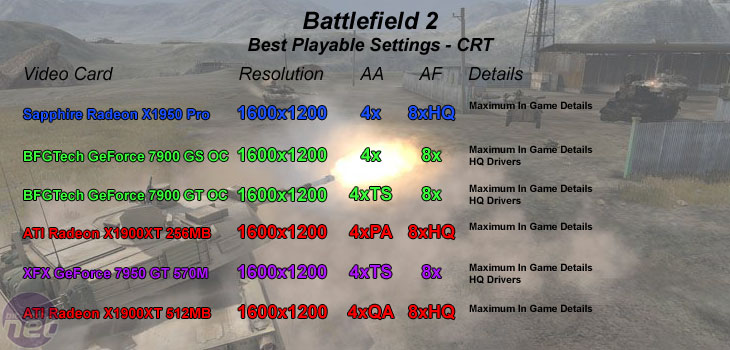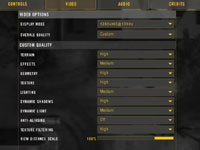CRT Gaming:
For gameplay evaluations on a 24" widescreen monitor, please head straight to our widescreen performance section.Battlefield 2
Publisher: Electronic ArtsBattlefield 2 features an all-new game engine based on the DirectX 9.0 API. There is no Shader Model 3.0 support, but the majority of hardware will use a Shader Model 2.0++ mode that includes support for Normal Maps, Parallax Mapping, Full-Resolution Dynamic Shadowing, Post Processing and Fog.
The game will look the same on both NVIDIA and ATI hardware, so there is no advantage of choosing one over the other in image quality related circumstances. The only major difference is that Ultra Shadow 2 is utilised on NVIDIA's hardware, while the shadowing on ATI hardware is done using a slightly different technique.
We patched the game to version 1.4 and then played three five-minute segments of the 'Strike at Karkand' map, reporting the median frame rate. We found that there was no ready way to duplicate testing situations manually in this game, so we felt that taking a typical slice of action from the game was the best way to report our findings. We controlled anti-aliasing from inside the game, while anisotropic filtering was set to 8xAF when the 'Texture Filtering' option was set to 'High'.


We were still very impressed with the performance delivered by both of these cards at standard resolutions. On the image quality front, we have to give the nod to the Sapphire Radeon X1950 Pro, as there were some occasions where NVIDIA’s hardware again suffered from the dreaded texture shimmering problems. As a result, we forced high quality driver settings in order to remove as much of the shimmering as possible. Gravel-type textures in particular suffer from the over-zealous texture filtering optimisations.

MSI MPG Velox 100R Chassis Review
October 14 2021 | 15:04










Want to comment? Please log in.